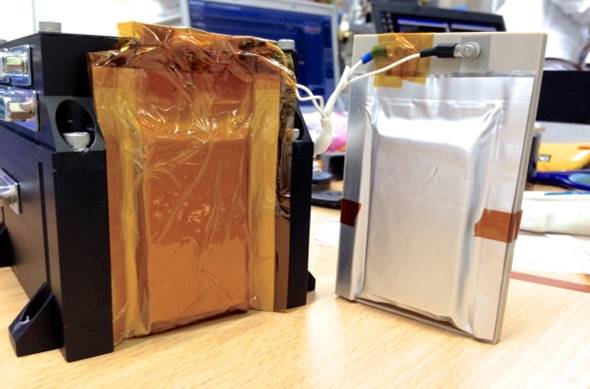Succeeded in the world for the first time for charging / discharging on Earth orbit

Professor Masashi Ishikawa of Kansai University (CEO of our company) and iElectrolyte Co., Ltd.
succeeded in the world’s first charge and discharge on ionic liquid lithium ion battery on Earth orbital. (Ionic liquid lithium ion battery was mounted on artificial satellite “Hodoyoshi 3” launched on 20th June 2014)
~Background~
After the launch of ” Hodoyoshi 3 ” on June 20, on August 5th we succeeded in the world’s first charge and discharge (short time) on the orbit of the ionic liquid battery installed in the satellite, and on 27th October We also succeeded in charging and discharging test for a long time.
From the obtained data, it became clear that there is almost no deterioration due to the influence of the space environment despite long-term space stay. This secondary battery uses an ionic liquid with almost no vapor pressure as the electrolyte, so we succeeded in making it a space battery only with a flexible and thin aluminum laminate exterior. This makes lightweight, thin, compact batteries, without requiring robust vacuum-resistant exterior and resin molds, which were necessary for conventional space batteries at all. Currently, we have about 6 months of orbital staying smoothly, and it is expected that it will be applied as a safe and highly reliable storage battery even in extreme environments such as outer space and aviation.
An important result is ①this secondary battery can stably exist in outer space with flexible exterior only ②It is the same performance as the same type of batteries used on the ground.
In the ground test before the launch, this secondary battery passed the super vacuum test simulating space and did not show any deterioration in the irradiation test of cosmic radiation dose more than 5 years, so the officials said they are convinced that this battery is capable of space operation.
However, nine months have elapsed from the production of batteries to the launch, during which they also received high G and high vibration during launch, transport to the launch site (Russia), and spent as much as five months in outer space It is. We believe that it is meaningful that this laminated thin battery could demonstrate that there is no degradation other than the same change over time as the ground, despite such harsh conditions.
Future research and development of ionic liquid lithium secondary batteries for satellites will be promoted as a collaborative research between the Company and Kansai University. We are expecting that this battery will develop as a new generation storage battery specialized in safety and reliability used in extreme environments such as for space and aviation.
